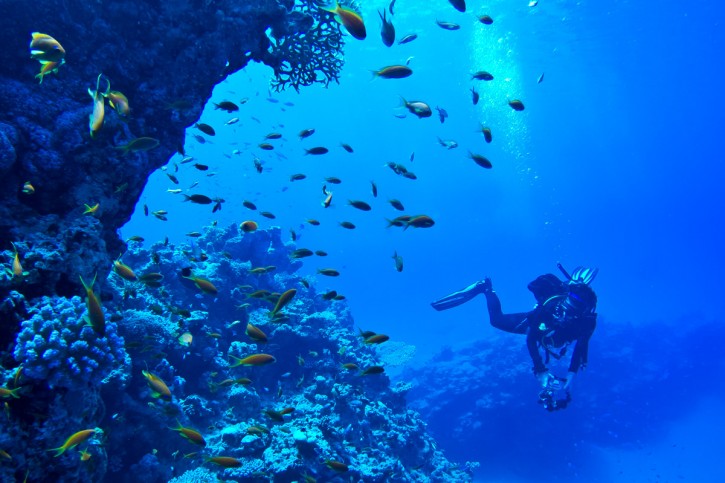Photo / Video News & Reviews
Duxy’s Underwater Photography Blog: Available Light, Part 4
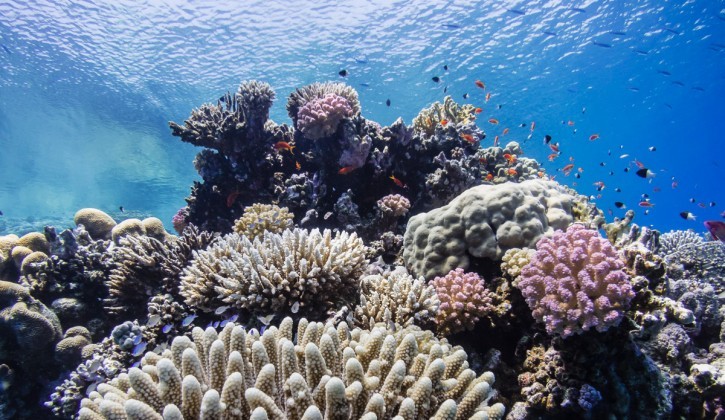
This is the final part in our series on shooting in available light. Part one was all about shooting with wide angle lenses; part two covered Custom White Balance; and part 3 was about the pitfalls and problems of shooting with Custom White Balance.
For the fourth and final instalment I am going to cover all of the extra bits and little things that don’t fall into the earlier sections.
So we are going to look at colour correction using filters and also colour correcting after the fact when you are shooting on a camera that produces RAW files.
Processing wreck shots, and whether or not to go black and white.
And is it possible to shoot available light macro?
Correction Filters and the Underwater Mode
Some cameras don’t have quick and easy to use Custom White Balance controls, which can put folks off. And they often want a one stop solution.
In days of yore, (and tbh sometimes these days too) with some cameras you had no option but to use a filter, which is normally of a reddish magenta colour, to restore colour balance to your underwater shots. And they work fine as long as you understand that they only really work within a very narrow band of depth, typically around 8-12m. This is because as explained in our earlier white balancing blog, our colours are diminished progressively as we get deeper, so any fixed method of colour correction such as a filter is really only going to work efficiently at one depth. And we would need a collection of filters of variable intensity as we got deeper, which is impractical to say the least.
To be honest, unless there is absolutely no alternative with your camera (GoPro’s and other cameras of this type fall into this category), I would steer away from conventional colour correction filters because they also steal quite a bit of light from you. Or as in the cases below only shoot with them really shallow – no deeper than around 8m – for the best results.
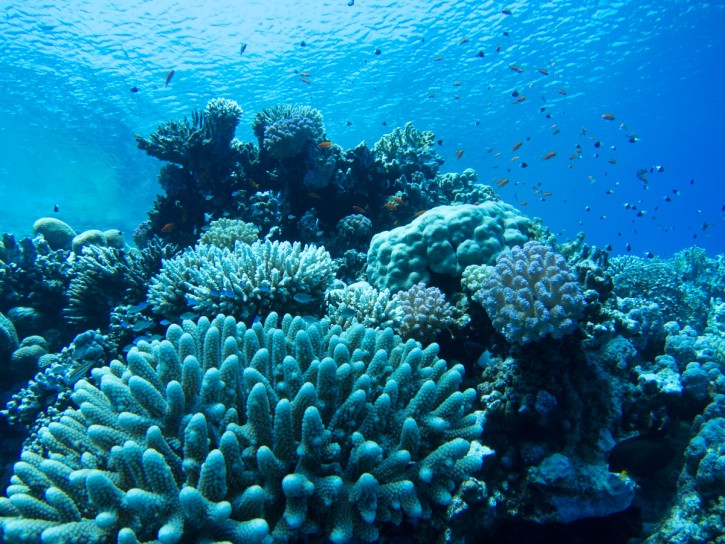
A classic reef scene that could be taken with any camera from a GoPro upwards. This is unfiltered and what a lot of people experience when first shooting underwater.
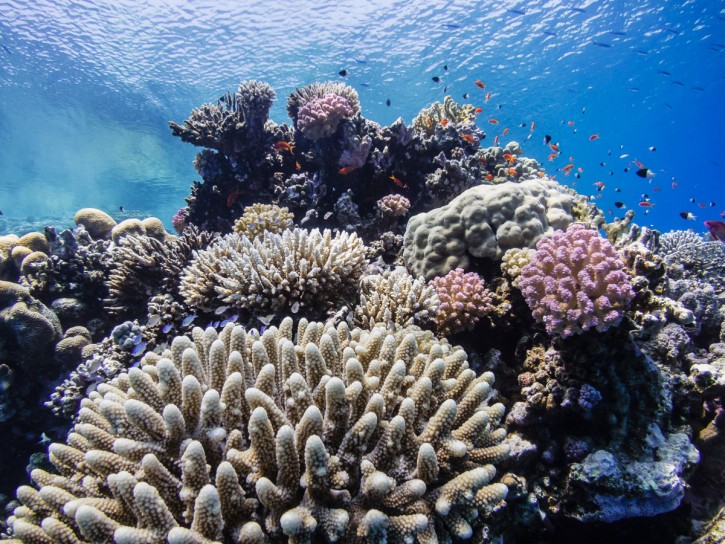
Here the same shot as previous, but this time I’ve used a colour correction filter to restore the colours. Note however that I am very shallow and this is where these filters work best.
Some cameras have a dedicated underwater mode, but this is usually little more than an electronic version of a coloured filter and doesn’t always do much, but of late I’ve seen some more promising offerings of this sort of thing from Canon and Olympus.
Here’s a video I shot using the underwater mode on an Olympus Mirrorless camera, an EM5:
https://www.youtube.com/watch?v=Ulat1Z6L0qk
Shooting in the RAW
Probably the very best way to colour correct your pictures, even if you have the option of custom white balance, is if your camera will allow you to shoot RAW files.
Now if you are not sure, the chances are that your camera won’t, as the ability to shoot RAW will be something you will probably have looked at when buying a camera, and also the salesman will have made a big deal out of it, because it is a big deal. So you know what to ask for when you purchase your next camera.
RAW files are simply the actual data recorded at the sensor and are not processed into a jpeg file within the camera.
The means that you can have full control after you’ve taken your shots to process the pictures yourself, and really fine tune things like colour correction, white balance and even exposure to a lesser degree. This processing you would do within a program like Adobe Photoshop or Adobe Lightroom, and this is why things like RAW shooting are available to people with high end compact cameras or Mirrorless and DSLR shooters.
It’s nothing to be intimidated about and processing RAW files is a relatively easy task, and is also quite fun too. A bit like the modern equivalent of having a home darkroom, but without the dangerous chemicals and fumbling around in the dark!
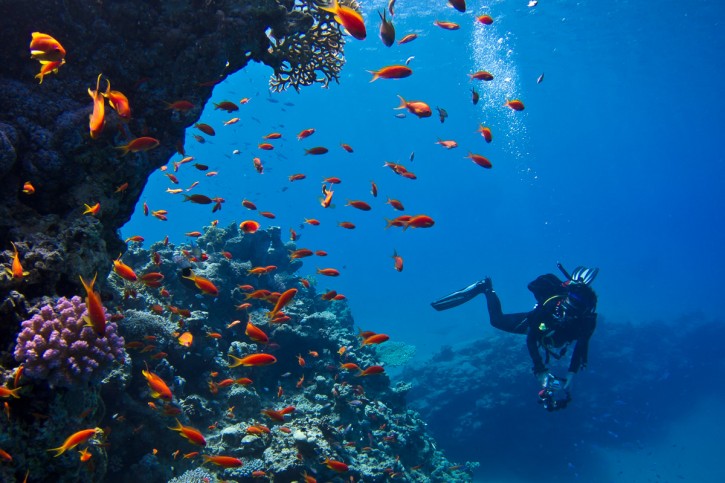
After colour correction within Adobe Lightroom, the RAW file has allowed me to completely restore the colours, but beware – this won’t work miracles, and at depths greater than 12m, it has less usefulness, and maybe using a strobe would be better.
Macro Photography in Available Light
Underwater macro or close up photography is often thought to be only practical if you use extra lighting of some kind. If you encounter subjects that are in good light like the Hawkfish below, then there is no reason as long as your shutter speeds and apertures of your camera will allow to shoot with what the sun is providing for you. This can often be simpler and produce more naturalistic results.
So keep an eye on what your camera is telling you, and if the camera shake warning is flashing then you may need to up your ISO’s to provide a suitable shutter speed to hand hold. On that note hand holding close up shots is more tricky than wide angle so you may need to pick (or force shutter speeds with a higher ISO) than you could get away with with a wider lens. I try and keep above 1/250 of a second if shooting like this.
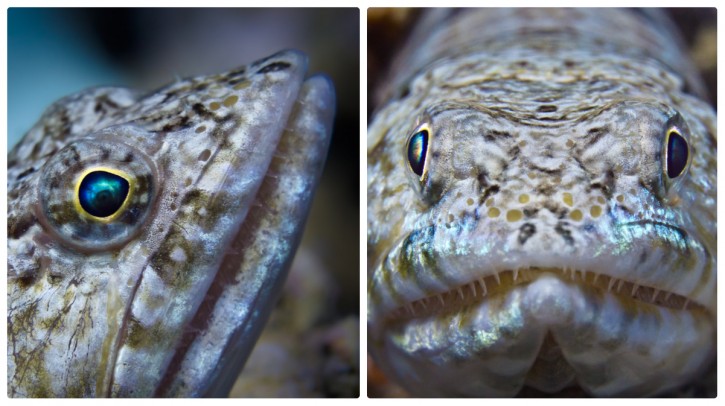
This Lizard fish is about as close as you could expect to shoot successfully without a strobe. These guys are often in very shallow water, laying on bright well lit sand, so are a very suitable subject for available light macro photography.
Fish portraiture like this is perfectly achievable using available light, and allows you to capture the subject exactly as you see it. The things you need to watch out for are that your shutter speeds are sufficiently high enough to hand hold your camera set up, because in macro mode you may also be zoomed in slightly so any movements you make will be magnified. These two shots below were typical examples of pictures where I wanted to get the shot exactly as I was seeing it, and whilst the Crocodile Fish is only just qualified to be called a macro picture, everything I’ve said above applies.
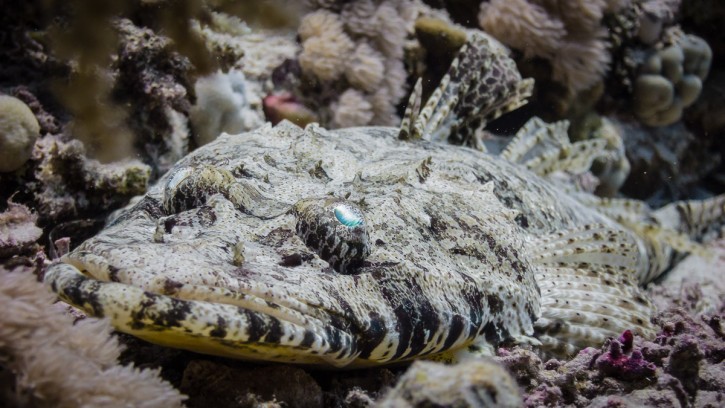
Fish Portraits like the ones here shot using compact cameras and underwater white balance, or RAW files, is very possible in very bright light conditions.
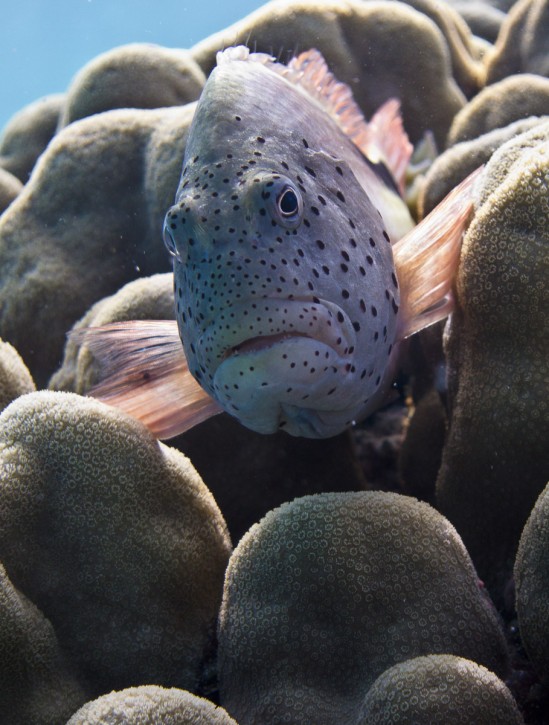
Macro Photography is normally the preserve of someone shooting with strobes only, but as long as you are in good light Macro photography is possible.
Available light wreck shooting
A very popular subject for available light shooting is to shoot big expansive wreck photographs, and often shooting available light is the only way possible to light such a large object, because even with the most powerful strobes it would be nigh on impossible to completely illuminate a large subject like a wreck. Unless the light conditions are in your favour, and the wreck is positioned so that the sun is directly illuminating it, when you want to shoot it, then getting your colours correct will depend hugely on all these variables. Just one of the reasons why people often choose to turn their wreck photographs to black and white – this not only heightens the drama and mood but is often the only get out clause to avoid weird colours, because the conditions are not in your favour.
For the stern shot of the Thistlegorm, I have actually used a little bit of flash, but it has only slightly lightened the very closest part of the wreck, and lifted it a little. To all intents and purposes the shot is being mostly illuminated by the late afternoon sunlight.
So I will leave it up to you which you prefer, the straight shot or the black and white toned version below it:
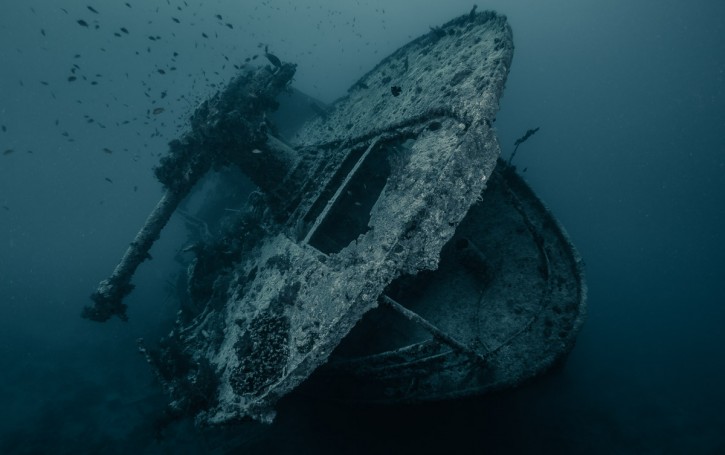
A shot at the stern, where I have been lucky enough to have no other divers in the scene, which if you’ve been to the Thistlegorm, you’ll realise is rare indeed. This is with only a tiny amount of flash lighting up the very closest part of the wreck.
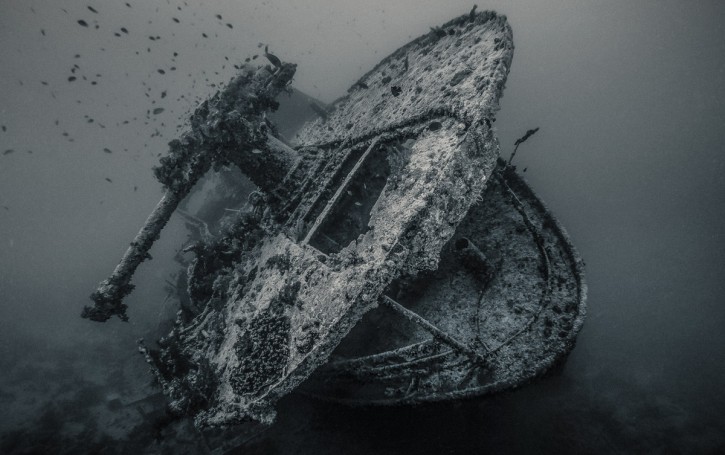
The black and white version of the stern shot of the Thistlegorm. It’s a matter of personal taste which one you prefer. Making black and white edits like this is a question I get asked a lot on our photo workshops.
The side on shot which is an unusual angle. I have given you the straight shot at the top with little or no editing, and then the more stylised black and white version below it:
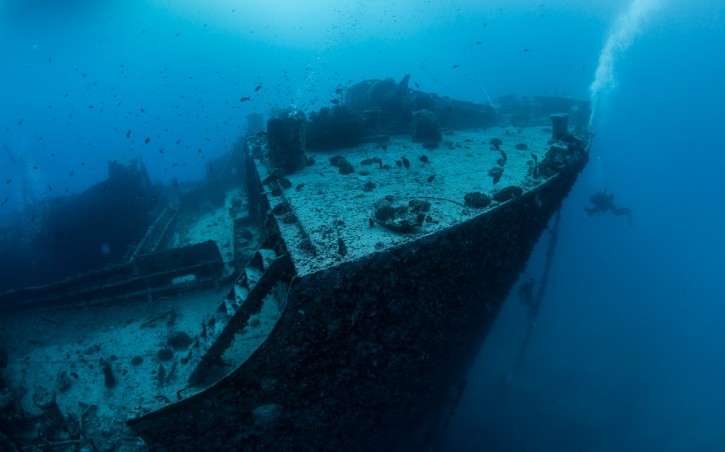
This is a rather untraditional viewpoint of the Thistlegorm, taken sideways on at the bow. The picture is a little soft at the edges because of the wide aperture I have had to use to gain a sufficiently fast shutter speed to hold the camera steady.
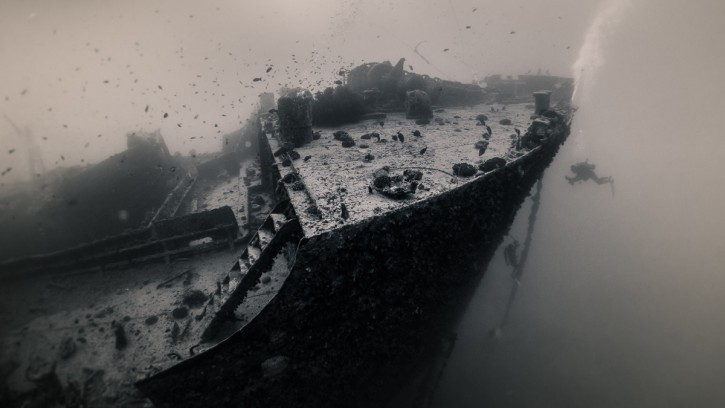
Because of the wide aperture I used which has softened the edges somewhat, I decided to opt for a black and white edit which actually highlights the softer edges to try and give it a dated and otherworldly feel.
Another alternative is to come on a dedicated wreck photography week where we will often dive the same wreck many times throughout the day to raise the chances of good lighting. I spend a lot of time on these trips teaching people how to edit their pictures, with black and white editing particularly popular.
I hope you’ve enjoyed this series on available light shooting. If you’d like to ask me any questions or talk about our photo trips please drop me a line at duxy@scubatravel.com.
[hr style=”single”]
 Duxy is the in house photo-pro for UK-based dive tour operator Scuba Travel. To find out about availability on Scuba Travel’s underwater photography workshops hosted by Duxy click here.
Duxy is the in house photo-pro for UK-based dive tour operator Scuba Travel. To find out about availability on Scuba Travel’s underwater photography workshops hosted by Duxy click here.
News
Meet Insta360 Ace Pro 2: Redefining Action Cameras With Unrivaled 8K Image Quality & Smarter AI

Insta360 is thrilled to announce the latest addition to its Ace series, Insta360 Ace Pro 2. This groundbreaking wide-angle action camera delivers unparalleled image quality, smarter, easier capture powered by AI, upgraded audio, and an improved rugged design made for action at its most extreme.
Co-engineered with Leica, it delivers serious performance upgrades with the industry-first dual AI chip and state-of-the-art imaging courtesy of a new 1/1.3″ 8K sensor and Leica SUMMARIT lens with a 157º field of view. Creators can experience smoother videos with higher frame rates at 8K30fps and 4K60fps Active HDR, PureVideo for excellent low light performance, a bigger 2.5″ flip touchscreen and more.
The action camera utilizes Insta360’s advanced AI technology to offer a smarter experience from shooting to sharing. Innovative functions like the option to pause or cancel a recording, gesture and voice control, Auto Edit, and AI Highlights Assistant completely transform the experience for creators. With no more complex workflows, anyone can experience a simpler way to film and spend more time immersed in the moments they love.

Insta360 Ace Pro 2 significantly improves on its design, offering a more rugged, reliable action camera. Its waterproofing has increased to 39ft (12m), and it offers crystal-clear audio with an integrated Wind Guard and a removable Lens Guard to handle whatever you throw at it, providing full flexibility for action and sports enthusiasts.
“Our goal was to refine and enhance the groundbreaking features of the original Insta360 Ace Pro to deliver an unparalleled experience,” says JK Liu, founder of Insta360. “We are confident these upgrades establish a new industry standard. Not only do they bring significant advances in AI, they empower creators to capture what was always impossible with other action cameras, opening the door to unprecedented creative potential.”
Insta360 Ace Pro 2 is available to order today worldwide via Insta360.com, as well as trusted retailers and select authorized partners.
Unparalleled Image Quality, Day and Night
The Leica SUMMARIT lens immediately sets it apart from competitors with its state-of-the-art image quality. Combined with an upgraded 1/1.3″ 8K sensor offering 13.5 stops of dynamic range, Insta360 Ace Pro 2 delivers simply breathtaking visuals in situations other action cameras simply can’t handle.
Further contributing to its image quality and performance is the industry-leading dual-chip design. Insta360 Ace Pro 2 is the first action camera with a dedicated Pro Imaging Chip that handles image processing and noise reduction, while a separate 5nm AI Chip handles further image processing and overall camera performance, providing a smooth, seamless user experience. The dual chip also enables more shooting modes and higher specifications, such as 8K30fps video, 4K60fps Active HDR (High Dynamic Range), and upgraded PureVideo. Even in fast-moving motion and high-intensity action, creators can enjoy smooth, sharp videos thanks to the higher frame rates or slow it all the way down with crisp 4K120fps slow motion.
A complex, custom-trained AI neural network underpins PureVideo, a specialized shooting mode that drastically reduces noise and enhances details in real time for cleaner, brighter images, even in extreme low light. Whether it’s twilight strolls or evening rides, creators can record what they never could before. For the daytime, upgraded 4K60fps Active HDR brings out all the details in intense highlights and shadows for more vibrant footage. Meanwhile, a wider 157° lens FOV captures more of the surroundings, perfect for vlogging or when the scenery really matters.
Exclusive Leica-engineered color profiles infuse footage with their signature aesthetic, adding a touch of elegance to every shot. Insta360’s devotion to color accuracy is seen elsewhere with Insta360 Ace Pro 2’s ability to retain rich and precise colors, even underwater.
Ready for Action Anytime, Anywhere
The upgraded design proves to be even more rugged, ready for when you ramp up the action. Waterproofing has increased to 39 feet (12 meters) or 197 feet (60 meters) with the Dive Case, and it handles temperatures as low as -4ºF (-20ºC) with ease, perfect for winter sports and extreme climates.
The new, removable Lens Guard provides greater all-around protection, meaning creators can feel confident to push the limits further and capture the impossible, knowing their action cam is up to the challenge.
An all-new Wind Guard keeps wind and noise at a minimum during those peak moments, ready to snap on and off as you need. With refreshed audio algorithms bringing professional-grade clarity to your content, you can immerse your viewers like never before. What’s more, the magnetic mounting system lets you seamlessly switch between accessories. Less time spent unscrewing and screwing your camera and mounts, more time in the moment.
Insta360’s leading FlowState Stabilization technology ensures videos remain incredibly smooth no matter what, while 360º Horizon Lock, now applied automatically in-camera, keeps everything perfectly level. Prioritizing performance and convenience, Insta360 Ace Pro 2 sports a bigger 1800mAh battery and a new Endurance Mode that offers a 50% longer runtime at 4K30fps than Insta360 Ace Pro. Fast charging powers the battery to 80% in 18 minutes or 100% in 47 minutes, so you can get back to the action quicker.
Insta360 has expanded its compatibility with several top third-party sports accessories, allowing action and sports enthusiasts to add a new level of detail. For data-rich videos, overlay real-time stats from third-party sports brands, including Garmin, Apple, COROS, and more. Alternatively, users can add stats from their phone directly in the Insta360 app without any extra gear or use the GPS Preview Remote for easy live preview, remote control, and real-time GPS data. For moto vloggers, pair Insta360 Ace Pro 2 with your motorcycle helmet headset from Sena, Cardo, and more for clear dual-track audio and hands-free control every ride.
Made for those who demand the highest standard of action capture, Insta360 Ace Pro 2 offers the perfect combination of durability and high-quality performance to capture life’s thrills with confidence.

Smarter, Easier Capture & Editing
Insta360 Ace Pro’s flip touchscreen proved an essential and convenient tool for creators and has been further upgraded to 2.5 inches. With a 70% increase in pixel density, a 6% increase in brightness and a 100% increase in flip durability, it allows for perfect framing and easier preview for vlogging, selfies, and difficult angles, all while remaining visible under bright sunlight. Instead of guessing if your shot looks perfect, you can shoot with confidence, knowing it is.
Internally, Insta360 Ace Pro 2 offers innovative solutions to problems that have hindered action enthusiasts for years:
- 4K Clarity Zoom – Want a close-up but the image quality becomes too grainy? Zoom in and out 2x without losing quality.
- Pre-Recording – Never miss a moment with up to 120 seconds of footage saved before you even hit record.
- Gesture & Voice Control – Use quick hand signals or verbal commands to control the camera, such as start/stop recording or take a photo, ideal if it’s mounted out of reach.
- Pause/Resume Recording – Got time between shots? Hit pause and continue recording when you need to keep everything in one continuous file for easier file management and editing.
- Timecode – Seamlessly synchronizes multiple cameras for an efficient editing workflow.
Insta360’s revolutionary AI features demonstrate a commitment to making shooting and editing as accessible as possible. Anyone, regardless of their skill level, will be amazed at what they can create. For those who aren’t confident editing, AI Highlights Assistant automatically finds the best moments from a video and delivers the highlights for review, all in-camera. Creators can merge every thrilling moment into one incredible recap or choose the ones their favorites and delete any unwanted clips to save storage.
The Assistant also helps craft your next reel from your adventures and pushes it directly to your smartphone via the Insta360 app. Look back on all your Memories and share those unforgettable moments in seconds.
Acting as a full editing suite in your pocket, the Insta360 mobile app fully embraces the game-changing possibilities of AI with advanced Auto Editing, one-tap templates and creative Shot Lab effects. Instead of spending hours learning complex tools and editing workflows, AI does it all for you, bringing your clips to life with dynamic cuts and transitions. Creators can even achieve the infamous Invisible Selfie Stick effect with the AI Selfie Stick Eraser in the app for third-person views. Looking for a real twist? AI Warp uses preset or custom keywords to bring your wildest ideas to life.
Available Now
Insta360 Ace Pro 2 is available to purchase today worldwide via Insta360.com and select retailers. The Standard Bundle retails for US$399.99 and includes a Wind Guard, Battery, Standard Mount, Mic Cap, and USB-C Cable. The dual battery bundle includes the same accessories and two batteries for US$419.99.
News
Introducing the Nauticam Super Macro Converter 3

The SMC-3
Nauticam is proud to introduce the SMC-3, the latest evolution in our line of water contact optics! Designed as a renewed version of the acclaimed SMC-1, the SMC-3 boasts a lightweight build—now only one-third the weight of its predecessor—without compromising on optical performance.
SMC-3 Specifications
| Dimensions | OD 70mm x H 32mm |
| Weight in Air | 307g |
| Weight in Water | 215g |
| Max Magnification (*1) | 2.4x (lens dependent) |
| Working Distance (*1) | 51-103mm |
| Lens Construction | 3 elements in 2 groups |
| Lens Coatings | Anti-reflection Coating |
| Mount Thread Diameter | M67 |
| Depth Rating |
100mm |

Tested with Nikon AF-S VR Micro-Nikkor 105mm f/2.8G IF-ED
Key Features
- Ultra-Lightweight Design: Weighing in at just one-third of the SMC-1, the SMC-3 offers unparalleled portability for on-the-go use.
- Superior Optical Performance: Enjoy the same exceptional clarity and precision you’ve come to expect from the SMC series.
- Increased Working Distance: The redesigned lens allows for a greater working distance, meaning it’s easier to use and provides enhanced versatility.
- Premium Materials: Crafted with advanced materials to enhance durability while minimizing weight.
- Cost-Effective: Slightly more affordable than the discontinued SMC-1, the SMC-3 delivers exceptional value.
Uncompromised Optical Quality
The Super Macro Converter 3 is constructed from lenses that are precision crafted of specially formulated low dispersion optical grade glass, ground to the most demanding standards. These exceptional measures, enhanced by broadband anti-refective coatings effectively reduce common optical issues such as chromatic aberrations, coma, spherical aberration, and field deformation associated with underwater macro photography using traditional magnifying lenses. These optics are assembled in a rugged hard anodized aluminum housing, and nitrogen purged during assembly to eliminate fogging.
Stunning Magnification
When combined with a full frame camera and a 100mm or 105mm macro lens, the device converts the optical system to provide a maximum of 2.4X magnification factor. In other words, a subject area of 15.6mm X 10.4mm will fill the whole frame of a 36mm X 24mm sensor.
Improved Sharpness and Contrast
As the Super Macro Converter 3 is optimized explicitly for using together with a macro lens underwater, images captured exhibit exceptional sharpness compared with conventional magnification lenses. Thanks to the broadband multi-layer anti-reflection coating on each surface of the lenses, images also exhibit higher contrast.
Superb Light Transmission
All the lens elements installed inside the SMC are optically optimized to appropriate diameters so as to provide maximum light transmission. The SMC doesn’t suffer from vignette issues under even the most extreme conditions. The broad band multi-layer anti-reflection coating on all surfaces also greatly improves light transmission.
Optimized for Autofocus
By utilizing a specially developed algorithm in the optimization process, the SMC renders superior image quality over the full focusing range of the camera lens (which becomes ~50 to ~100 mm in front of the SMC). Also benefitting from the high brightness and contrast of the image, the autofocus system of the camera usually works acceptably well within this range.

Ample Working Distance
Even at the maximum 2.3X magnification, there is still more than 50mm of working distance between the front element and the subject with 100/105mm macro lenses. This working distance is crucial when capturing behavior with skittish subjects.
Resolution
High resolution was a primary design goal of the SMC project. This has been achieved using computer aided optimization and high grade optical glasses with unique refractive and dispersion properties. Images taken with this new system exhibit very high resolution and quality. Results have exceeded expectations, and these images rival the quality of the macro lens in air.
Smooth Bokeh
The Converter retains the optical properties of the macro lens for the whole system underwater, resulting in a blurred (out of focus) background that has a pleasing smoothness and creamy look, without the normal purple and green fringing.
Avoiding Diffraction
Due to the overall superior optical performance of the SMC-3 it is possible to shoot larger apertures with excellent image quality. This avoids reaching the diffraction limit of high resolution sensors, and allows selective focus effects with narrow depth of field in super macro images.
For more information about the Nauticam Super Macro Converter 3, which ships in November, click here.
-

 News4 weeks ago
News4 weeks agoIconic SS United States to become the World’s Largest Artificial Reef
-

 Blogs3 months ago
Blogs3 months agoNovoScuba’s Game-Changing Approach for Dive Store Owners: WE PAY YOU!
-

 News2 months ago
News2 months agoBook Review – 52 Assignments: Underwater Photography
-

 Marine Life & Conservation3 months ago
Marine Life & Conservation3 months agoBook Review: Sharkpedia
-

 Gear News2 months ago
Gear News2 months agoDYNAMICNORD – New German diving brand enters the British market
-

 News1 month ago
News1 month agoExploring Cenote El Pit: A Diver’s Dream
-

 Gear News2 months ago
Gear News2 months agoTry BARE drysuits (and maybe even win one!) this Friday with Sea & Sea at North West Dive Fest
-

 News2 months ago
News2 months agoComing Soon – 52 Assignments


